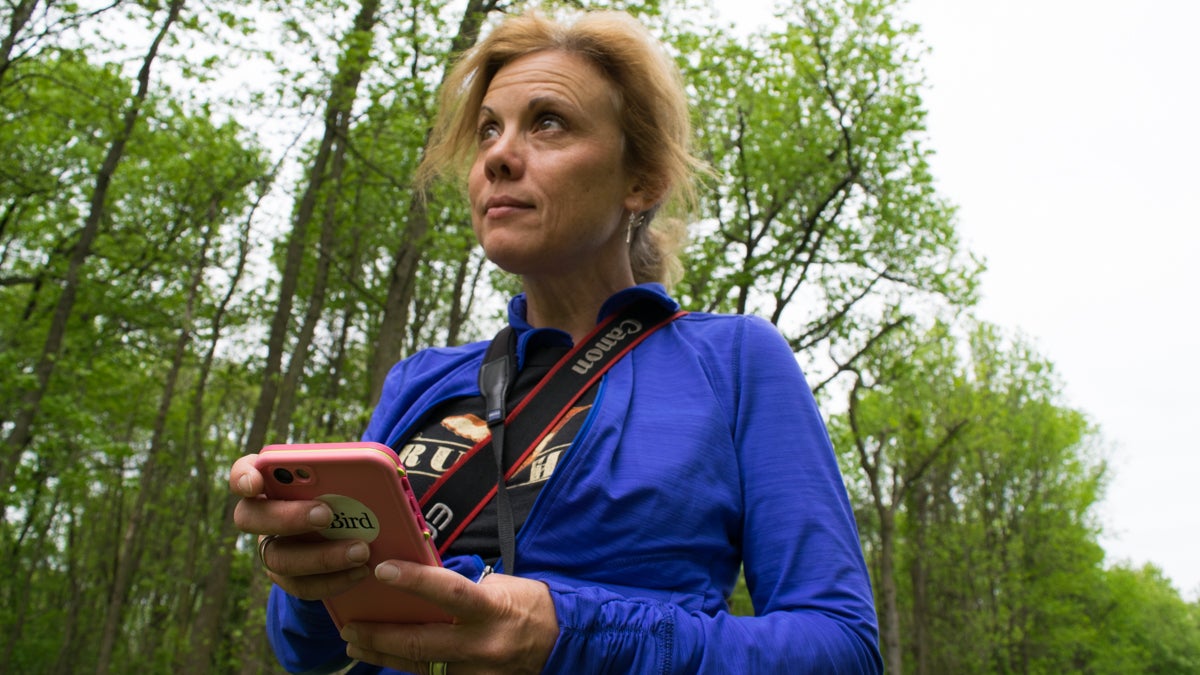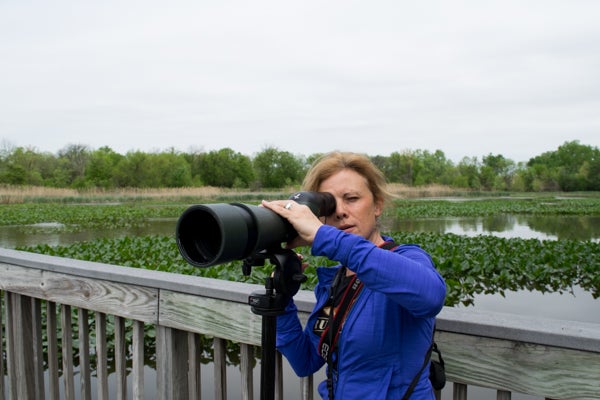With the click of a button, birders become citizen scientists
Ornithologists are getting research help from more than 360,000 people around the world who use the eBird app.
Listen
Holly Merker enters her bird count into the app, eBird. (Paige Pfleger/WHYY)
Holly Merker’s eyes are constantly on the tree tops.
During a outing to the John Heinz Wildlife Refuge at Tinicum on the outskirts of Philadelphia, her small frame is bogged down by more gear than a movie crew.
She has binoculars hanging from her neck, a huge camera draped over one arm, and her spotting scope is perched on her other shoulder.
As a small bird flits from one tree to another, Merker pulls up her camera and snaps a photo. She takes out her iPhone and starts recording the bird singing.
She’s a 21st-century birder, and her smartphone has become part the arsenal of tools she uses to document the animals she sees.
“I’ve been birding for a long time,” Merker says, “before we ever had smartphones … I feel it’s really enhanced my experience!”
She opens up an app called eBird, and starts tapping away.
“So right now I’m putting in, I can hear a Carolina wren singing. I want to put a value for some of the Yellow-rumps that we were seeing … ” She enters the names of the birds, and then the numbers that she’s seen on her walk so far. “I’m going to enter in the number nine for that little path right there.”

eBird is more than just a checklist for birders like Merker who embrace technology. It’s also the single largest, and the fastest growing, biological citizen science project in the world. Merker is one of 360,000 birders globally who use eBird to enter bird data. That’s according to Ian Davies, eBird’s project coordinator. The app is the digital darling of the Cornell Lab of Ornithology.
“Birders are kind of this pre-existing network of people around the world, almost like sensors in our environment to understand how birds are changing … and as a result, the world is changing around us,” Ian Davies explains.
To get birders to contribute, the lab made eBird like a game.
“In Pokemon, you learn 150 kinds of creatures, you learn where to find them in the environment and then you go and collect them,” Davies explains. “In birding it’s almost the same thing, but there’s 10,000 species of birds, they’re all around the world … By observing them, you both get the satisfaction of seeing something new, but also, with eBird, of contributing to something larger.”
The data is free and available to researchers, and has been used in more than 100 studies since the app was created 15 years ago. One of those studies was done by Scott Taylor, a researcher at the University of Colorado Boulder. He used eBird data to show that warming winter temperatures are forcing two species of chickadees further north.
“There’s a lot of challenges that people who study birds face,” Taylor says. “One of those is that you can only be in so many places at one time. But eBird increases our ability to look across entire regions of contact between species.”
Taylor says that, without eBird, the study he and his fellow researchers did wouldn’t have been feasible. It would have taken much more money and time to do the field research. eBird users basically gave the scientists extra eyes and ears all over their research area.
Researchers love having citizen science data, but they need to trust it.
To make sure scientists feel confident in the information collected, eBird enlists data reviewers, such as Holly Merker. She reviews eBird sightings for the entire state of Pennsylvania. eBird flags an unusual sighting and then Merker goes into eBird and either verifies it or works with the birder to reach the proper identification. That way the birders can learn from their mistakes and the data quality improves.
After a few hours of birding at John Heinz Wildlife Refuge at Tinicum, Merker adds the finishing touches to her eBird list. Then she presses submit, and her data is off to Cornell.
“I love being able to contribute. Hitting the button is pretty awesome for me. It is totally nerdy. Bird nerds! But hey, I love it!”
She packs her gear into the back of her SUV, and tucks her iPhone, adorned with an eBird sticker, into her back pocket. She keeps it within easy reach because it’s the most wonderful time of the year for birders — migration season.
WHYY is your source for fact-based, in-depth journalism and information. As a nonprofit organization, we rely on financial support from readers like you. Please give today.



